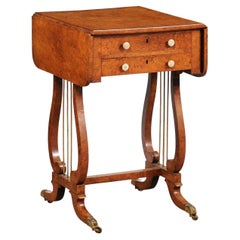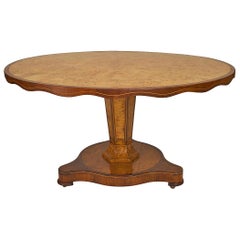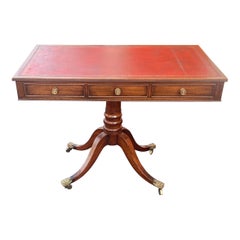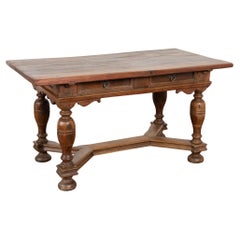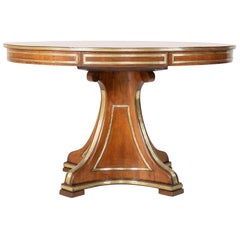Baltic Tables
to
Height
to
Width
to
Depth
to
2
2
3,764
2,459
567
382
226
208
183
174
155
139
116
114
92
74
71
40
31
16
2
2
1
1
1
1
2
2
2
Style: Baltic
Early 19th Century Baltic Sewing Table in Birch with Drop Leaves, 2 Drawers
Located in Atlanta, GA
Early 19th Century Baltic Sewing Table in Birch with Drop Leaves, 2 Drawers
Category
Early 19th Century Antique Baltic Tables
Materials
Birch
Continental Burl Wood Center Table
Located in Queens, NY
Continental possibly Baltic (circa 1850s) burl wood and mahogany trim center table with an octagonal base supported on a triangular base with a top having a scalloped apron.
Category
19th Century European Antique Baltic Tables
Materials
Mahogany, Burl
Related Items
19th Century Georgian Leather Top Table with Side Drawers
Located in Richmond, VA
Unique form 19th century Georgian leather top table with side drawers. Great quality mahogany, leather top and castors.
Category
19th Century English Antique Baltic Tables
Materials
Leather, Mahogany
$2,550 Sale Price
25% Off
H 30 in W 40 in D 22.75 in
Early 19th Century Oak Refectory Library Table with Two Drawers
Located in Round Top, TX
This handsome baroque oak library table with two functioning drawers has heavily turned legs and an attractive X lower stretcher.
Note the rich patina of the top, and different color...
Category
Early 19th Century Danish Antique Baltic Tables
Materials
Oak
Porto Center Table, by RAIN, Contemporary Center Table, Laminated Oakwood
By RAIN
Located in Sao Paulo, SP
Porto low tables are composed of a circular top that seems to rest on a sturdy oblong base. Lightness and weight overlap creating a harmonic and unconventional monoblock.
The unagreement between the geometry of the elements generates irregular pieces capable of evoking movement, as they elude the gaze, changing according to the viewing angle.
The tables give continuity to the Porto collection, whose inspiration comes from the weight and scale...
Category
2010s Brazilian Baltic Tables
Materials
Wood
$3,900 / item
H 11.42 in Dm 45.28 in
19th C. French Charles X Restoration Period Sewing Stand Work Table
Located in Forney, TX
A scarce period Charles X (1818-1834) French Restoration mahogany travailleuse sewing (thread stand - side table - jewelry dressing table) with light, warm, beautifully aged patina.
Born in France in the early 19th century, almost certainly Parisian work, exquisitely hand-crafted, this exceptionally executed example features ornate gilt bronze ormolu mounts, escutcheons, and elaborate gilt metal trim. Having a highly figured light mahogany hinged lid top, lifting open to reveal a striking finished interior with divided compartments and original inset mirror plate. The conforming rectangular case fitted with a faux drawer front over a dovetailed drawer with sectioned interior. Elegantly rising on oval-shaped medial shelf stretcher-joined curvacious legs.
Dimensions (approx):
27" High, 20" Wide, 13.5" Deep
Stunning light almost blonde antique mahogany coloring and mellow warm tone, superb wood grain detail, and charming, beautifully aged patina over the whole. Great shape overall. Retaining original antique character marks, wear consistent with age and indicative of minimal use, nothing that detracts from the aesthetics or functionality, but only adds to the overall authenticity, refined elegant warmth, luxurious sophistication, and cozy unpretentious rustic elegance.
Delivered cleaned, hand waxed, polished French patina finish, ready for immediate use and generational enjoyment!
What is Charles X style:
The comte d’Artois – or Charles X - was the son of the dauphin Louis-Ferdinand de Franc and Marie-Josèphe de Saxe. He succeeded his two brothers Louis XVI and Louis XVIII and became the King of France in 1824. Thirty years after the French Revolution, he wanted to embody the return of monarchy and became the leader of the catholic party . As the previous kings, he was crowned in 1825 but he was soon overthrown by the revolution in July, 1830, called "Trois Glorieuses". He left then for England, Scotland, Prague and Istria where he died in 1836.
Charles X style lasted from 1818 to 1834 and happened during the Bourbon Restoration (French Restoration). This style did not replace totally the style of furniture from the French Empire but it was different from the formalism in the Napoleonic era, during which strictness and simplicity were inspired by Greco-Roman art. Indeed, artistic fields flourished. In terms of furniture, this renewal was suggested by the softening of shapes. Even though the simple aspect from the French Empire was still visible, shapes became curvier with volutes and arabesques. Another distinction is the loss of the massive aspect of furniture and the decrease of dimensions in order to decorate smaller appartments. Handling ability and comfort were key-words in the making of furniture. Apartments had essential elements such as chests of drawers, big rounded tables in the dining room, desks or secretaries, armoires and even dressing tables, comfortable fainting couches in the living room, small tables, pedestal tables, as well as gondola chairs. The wavy aspect of the latters certainly represent Charles X style the best.
One of the most emblematic features of this style is the use of bois clairs – light woods in warm blond tones - and indigenous woods that are varnished in order to highlight the grains. Bird's-eye maple, ash trees, plane trees, yew trees, beech trees, olive trees and cedar trees were most likely to be used. Indeed, at the beginning of the 19th century dark woods were hard to find. In 1806, the Napoleon’s Continental System was established in order to ruin the United Kingdom by preventing the country from any business with the rest of Europe. Therefore craftsmen had to find alternatives from mahogany which was the most commonly used material at this time. After 1815, the import of wood was even more difficult because of peace treaties and the European political situation, which contributed to the popularity of the bois clairs and indigenous woods. The furniture was often decorated with fine inlays made out of dark wood representing foliage, which contrasted with the veneer. Even though these patterns can look like bronze decorations from the Empire era, they were far more simple and did not represent any military or mythological attributes. On the tables, trays were sometimes made out of marble as in the French Empire, but it was often put aside and inlaid veneer, Verre Eglomisé – a type of glass with a mirror finish –, mirror or porcelain from Sèvres or Paris were more likely to be used.
Decorative elements from the Monarchy were highly appreciated again as they suggested luxury. Indeed, marquetry work was particularly fashionable - Boulle marquetry thrived around 1820 as the works of the Levasseur family can show. In the same way, draperies and trimmings referred to the monarchist splendour. Fabrics were often white – the traditional colour of the Bourbons – or light coloured as oppposed to the typical green from the Napoleonic era.
One of the most symbolic figures from this period of time might be Jean-Jacques Werner (1791-1849), a cabinetmaker who worked for prestigious clients such as the Duchesse de Berry who was Charles’s step-daughter. His works can be seen at the Musée des Arts Décoratifs and at the Grand Trianon in the Palace of Versailles. The duchess’s appartments situated at the pavillon de Marsan and at the Palais de Saint Cloud illustrate Charles X style the best with furniture made out of bois clairs and ornamented with dark wood patterns or fine gold decorations.
Chales X style allows a transition between the sobriety of the Empire style and the abundant aspect of Louis-Philippe style. The gothic style started at this time through the "style à la cathédrale", inspired by religious architecture, which thrived from 1827 to 1830. Indeed, at the beginning of the 19th century, Romanticism put the spotlight on the Middle Ages. Cabinetmakers were not inspired by the medieval furniture but rather by architectural elements of churches and cathedrals. For instance the backs of chairs were decorated with arches shaped like rib and serration. In the same way, before Charles X abdicated, pieces of furniture were made out of dark woods – such as mahogany, which was used again in France – and were inlaid with light wood. Romanticism also influenced the layout of furniture in appartments to suggest movement through a mix of various styles, various shapes and various sizes, as opposed to the static aspect of Neoclassicism. The start of industrialisation and mechanisation also influenced this style as early technical developments led to the production of pieces of furniture in series.
Credit:
Marc Maison
Bibliography:
FANIEL Stéphane (Dir.), Le Dix-neuvième Siècle Français, Collection Connaissance des Arts, 1957, Hachette
SASSONE, Adriana Boidi, Furniture from Rococo to Art Deco, 2000, Evergreen
--
Extremely versatile:
As warm and attractive as it is useful, this remarkable antique table having the ideal size and small proportions for a variety of different uses, including as a side table, accent or occasional table, tall sofa...
Category
Early 19th Century French Antique Baltic Tables
Materials
Bronze, Ormolu
19th Century Walnut Drop Leaf Table
Located in New Orleans, LA
Category
Mid-19th Century French Antique Baltic Tables
Materials
Walnut
19th Century Mahogany Dining Table with Leaves with Brass Clips
Located in Huntington, NY
Table has 2 end sections and 2 leaves and brass clips. The table can be used as a pair
of side table against the wall. Great color and patina
Dimension...
Category
Mid-19th Century American Antique Baltic Tables
Materials
Brass
$4,320 Sale Price
20% Off
H 28.5 in W 50.5 in D 85 in
French 19th C. Mahogany Round Table W/Drop Leaves & Petite Brass Caster Feet
Located in Atlanta, GA
A French mahogany drop-leaf table from the late 19th century. This antique table from France has dual drop-leaf sides that when opened, create an over all round shape. The table is p...
Category
19th Century European Antique Baltic Tables
Materials
Mahogany
$2,793
H 19.75 in W 38.25 in D 37.75 in
Early 19th Century Cherry Hand-Planed Gate-Legged, Drop Leaf Dining Table
Located in Louisville, KY
Not your ordinary drop-leaf table, this early 19th century cherry gate-leg, drop-leaf table was hand-planed and hand-turned to create a wonderful dining table that doubles as a conso...
Category
Early 19th Century American Antique Baltic Tables
Materials
Cherry
$2,300
H 29 in W 48 in D 19.5 in
Large Antique Anglo-Indian Carved Padouk Wood Center Table, Mid 19th Century
Located in San Francisco, CA
Large scale exceptional and extensively hand-carved Anglo-Indian tilt-top table of padouk wood and rosewood. Having dragons, birds, animals, and an intricately carved frieze, with an...
Category
19th Century Indian Antique Baltic Tables
Materials
Rosewood, Padouk
French 19th Century Louis XVI Drop-Leaf Table
Located in Stockbridge, GA
French 19th century Louis XVI drop-leaf table.
Dimensions table opened: 63.5in. W x 44.25in. D x 29in. H
Dimensions table closed: 20in. W x 44.25in.D x 29in. H.
Category
Mid-19th Century French Antique Baltic Tables
Materials
Mahogany
19th Century Louis XV Style Tulipwood Parquetry Sewing Table
Located in Vero Beach, FL
19th century Louis XV style tulipwood parquetry sewing table
Ladies small sewing table with a lift-up lid. The interior has the original velvet inset. Beneath is a tray containing compartments for sewing accessories...
Category
Late 19th Century French Antique Baltic Tables
Materials
Tulipwood
Early 19th Century Mahogany Oval-Topped Occasional Table
Located in Dublin 8, IE
Early 19th century mahogany oval-topped occasional table, complete with single drawer featuring brass lock and swan neck handle, sitting above gently tapered legs supported by a simp...
Category
Early 1800s Irish Antique Baltic Tables
Materials
Mahogany
Previously Available Items
Neoclassical Mahogany Brass Mounted Oval Center Table
Located in Stamford, CT
Neoclassical mahogany brass-mounted oval center table with frieze drawers and quadripartite base. Russia, second quarter of the 19th century.
Category
Early 19th Century Baltic Antique Baltic Tables
Materials
Mahogany
Baltic tables for sale on 1stDibs.
Find a broad range of unique Baltic tables for sale on 1stDibs. Many of these items were first offered in the 19th Century, but contemporary artisans have continued to produce works inspired by this style. If you’re looking to add vintage tables created in this style to your space, the works available on 1stDibs include tables and other home furnishings, frequently crafted with wood, birch and other materials. If you’re shopping for used Baltic tables made in a specific country, there are and Europe pieces for sale on 1stDibs. It’s true that these talented designers have at times inspired knockoffs, but our experienced specialists have partnered with only top vetted sellers to offer authentic pieces that come with a buyer protection guarantee. Prices for tables differ depending upon multiple factors, including designer, materials, construction methods, condition and provenance. On 1stDibs, the price for these items starts at $2,450 and tops out at $42,500 while the average work can sell for $22,475.
Recently Viewed
View AllMore Ways To Browse
British Bulldog
Bronze Deer Statue
Bronze Musicians Figures
Bronze Sparrow
Bronze Unicorn
Brutalist Bull
Brutalist Horse Sculpture
Bruton Furniture
Buddha Head On Black Stand
Buddhist Monk Statues
Buddhist Temple Bell
Buffalo Statue
Butter Mold
Campaign Chest Secretary
Carl Aubock Fish
Cartier Limoges
Carved Eagle Plaque
Carved Lion Bed
